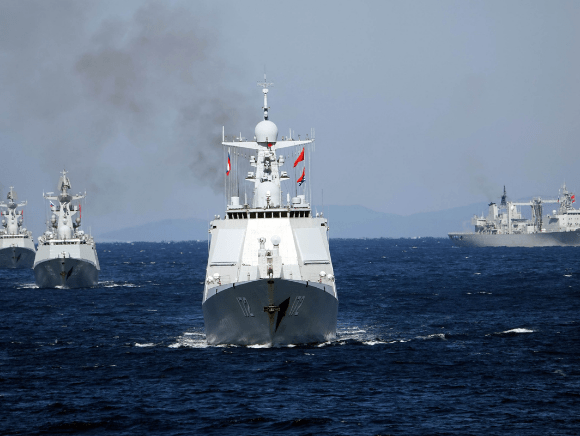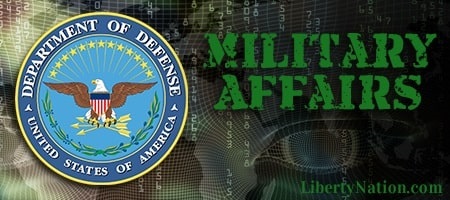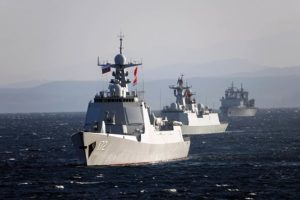The real threat posed by China’s rapidly expanding technology and the U.S. strategy to meet that challenge were topics discussed very candidly recently by military leaders in positions to know. The number two ranking military officer in the Defense Department, General John Hyten, vice chairman of the Joint Chiefs of Staff, discussed where the U.S. stands after the July 27 launch of a Chinese hypersonic missile. That’s the challenge. In the same week, the Center for a New American Security held an extended interview with Air Force Lieutenant General Clint Hinote, deputy chief of staff for strategy, integration, and requirements. The general provided some very straight talk about what to do about Beijing as well as other global threats.
The Hypersonic Challenge
David Martin, a long-time Pentagon correspondent for CBS News, interviewed the vice-chairman, and Hyten’s side of the conversation should give Americans and the Defense Department pause. “They launched a long-range missile,” Hyten told CBS News. “It went around the world, dropped off a hypersonic glide vehicle that glided all the way back to China, that impacted a target in China.” Asked if it hit the target, Hyten replied, “Close enough. They look like a first-use weapon. That’s what those weapons look like to me.”
The problem is, though the U.S. military services are developing their versions of hypersonic weapons, the technology is not coming online fast enough. As Liberty Nation observed, “China’s launch of a heretofore unknown missile should be a Sputnik moment for America.” When Martin asked General Hyten if he would equate Beijing’s hypersonic missile test to the 1957 Soviet Union Sputnik launch, the number two military leader responded, “from a technology perspective, it’s pretty impressive … But Sputnik created a sense of urgency in the United States … The test on July 27 did not create that sense of urgency. I think it probably should create a sense of urgency.”
Contrast General Hyten’s analysis with comments made by Secretary of Defense Lloyd Austin when asked about the Chinese Communist Party’s hypersonic missile launch. Carla Babb, writing for Voice of America, reported:
“Secretary of Defense Lloyd Austin said China’s hypersonic missile test over the summer drew ‘concerns’ about Beijing’s growing capability, but he said he did not compare it to Russia’s launching of the world’s first artificial satellite, Sputnik I, in the 1950s. ‘Those are terms that I wouldn’t use, I don’t personally use,’ Austin replied Wednesday [November 17] to reporters asking whether the July 27 launch was a ‘Sputnik moment.'”
 Not Understanding the Threat
Not Understanding the Threat
As he has done in the past, Austin continued to call the CCP and its military capability a “pacing challenge.” Pacing challenge? That is a level of abstraction leaving an impression that the U.S. and China got some runners together for a jog in the park, and the U.S. joggers managed to keep pace. China is a real, definable, present threat.
Writing for The Epoch Times, Andrew Thornebrooke makes that point. He says, “China’s ruling regime could be more willing to engage in international coercion and armed conflict in East Asia due to its efforts to reach parity with the United States, according to foreign affairs experts.” With nuclear-capable hypersonic weapons, Beijing is coming closer to parity with each passing day.
To address the threat that China and other global adversaries pose to the United States, Lt. Gen. Hinote presented what could be an effective counterstrategy in his detailed interview with the Center for a New American Security on November 16. Hinote’s words clearly indicated his belief that China represented a “threat.” Speaking as an Air Force leader, the general’s comments were centered on what the Air Force needs to do to thwart Chinese adventurism in the Pacific. He acknowledged that the air arm of the military had to change to meet the threat.
As he said, “We have to have a different Air Force for tomorrow’s challenges than we did for yesterday’s challenges.” He went on to point out:
“China in particular, but also Russia spent a lot of time, effort, and investment in how to figure out how to stop American airpower … Some of that would be good radars, and some of those would be good surface-to-air missiles, good fighter aircraft, good weapons. And, in fact, we see that China, for example, has invested in the spectrum of all those things. And they’ve put them in places where it’s very challenging for us. An example would be over Taiwan or to parts of Japan.”
Strategies for a New Era
The general explained the importance of the specter of a subject about which Americans do not want to think. China will hold the U.S. homeland in jeopardy. So, homeland missile defense becomes a critical concern. He pointed out that the intercepts of Russian aircraft intruding near or inside U.S. airspace are as high as they have ever been. So, as the interview moderator expressed it, “what is the theory of victory?”
Hinote explained that the task is to project air power “that can survive and defend” to protect U.S. friends and allies with whom the nation has defense agreements, like Japan, the Philippines, and, most recently, to stand in the way of aggression against Taiwan.
As the general put it, America will be thinking much more about using military power not just with fighters, ships, satellites, or cyber independently, but using all of those capabilities in integrated and connected ways. Additionally, combat units on the ground cannot stop fighting because higher headquarters’ communications are interrupted. If unit commanders understand the senior leaders’ intent, they will carry out that intent. Furthermore, a strategic goal is to break up large units into smaller fighting organizations and then disperse them over a wider area, as would be the objective in the Pacific. A dispersed fighting force makes the enemy’s problem much more complex.
Among the critical capabilities the U.S. will employ, Hinote believes large bevies of unmanned and autonomous air vehicles will play an important part. Also – and a capacity often lost among the shooters’ notions – the general emphasized the importance of logistics. The Pacific embodies the tyranny of distance. The U.S. must be able to move the essentials of combat to where they are needed. Airlift and sealift must be up to the task. Currently, it is not certain they are.
Though others have sounded the alarm and posed ways to meet adversaries’ threats, the two interviews coming in the same week seemed worthy of note. Of course, the Department of Defense is not oblivious to the menace China represents as it becomes bolder. Still, all the military leadership would do well to take counsel from thoughtful colleagues and members of the warrior community like Hyten and Hinote.
The views expressed are those of the author and not of any other affiliation.
~ Read more from Dave Patterson.






